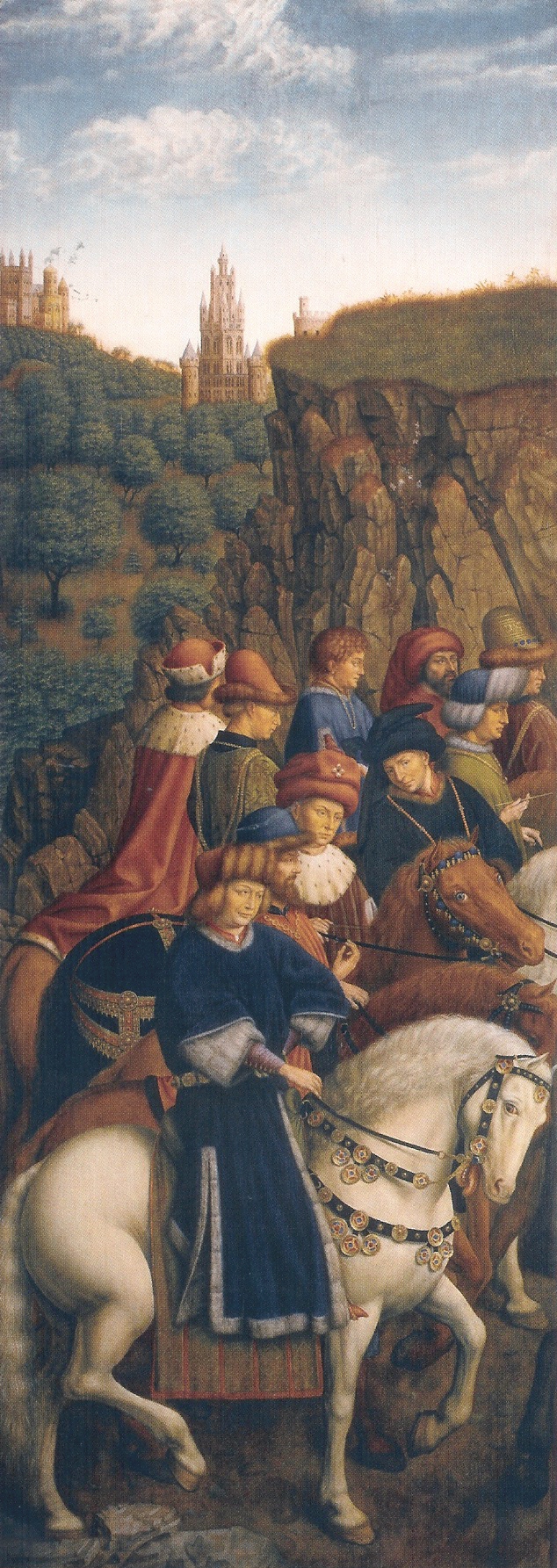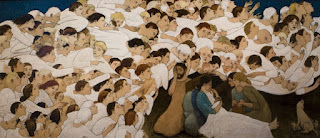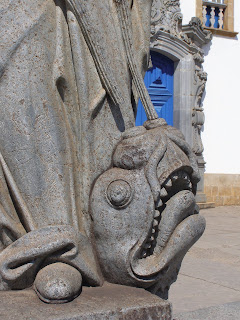Tuesday, February 9th, 2010
 I sometimes start my lectures by talking with students about art that has recently been in the news. Tonight, though, it was a student who shared an interesting news item. She had overheard people discussing this NPR story about Daniel Rockmore, a math professor at Dartmouth College.
I sometimes start my lectures by talking with students about art that has recently been in the news. Tonight, though, it was a student who shared an interesting news item. She had overheard people discussing this NPR story about Daniel Rockmore, a math professor at Dartmouth College.
Rockmore is using his mathematical skills to help determine if drawings are correctly attributed to Pieter Bruegel the Elder, a Northern Renaissance artist. Bruegel used various pen strokes which art connoisseurs have noted to be especially characteristic of the artist’s work. Nevertheless, connoisseurs have had difficulty in concretely identifying some of Bruegel’s work (e.g. the above image of an Alpine landscape (Morgan Library and Museum) was attributed Bruegel until recently). In order to help determine which strokes are Bruegel-like and which ones are not, Rockmore used his math skills to create a computer program that analyzes the pen strokes.
It sounds like an interesting program. It makes me wonder more about how computers and technology will affect the future practice of connoisseurship. Could future art attribution be left completely in the hands of technology, instead of actual connoisseurs? I imagine that couldn’t happen, but it’s an interesting/scary thought.
Rockmore made an interesting point at the end of the article, explaining that this program is a way to deconstruct art and determine what it means to be Picasso-like or Bruegel-like. In a way, I think that’s true, but I also think that an artist’s “hand” and styles can never be completely, concretely deconstructed. Even if an artist is relatively consistent in a technique, stylistic approach or color scheme, artists are subjective to change and variation. Although I think Rockmore has an interesting and useful idea, I don’t think it can find all of the answers to explaining an artist’s style.
Wednesday, January 20th, 2010
 I remember being surprised to learn that the Ghent Altarpiece (1432) that exists today is not entirely a product of the fifteenth century.1 One of the panels in the altarpiece (“The Just Judges“) was stolen in the 1930s, and was repainted by the copyist Jef Vanderveken in 1945 (see left).
I remember being surprised to learn that the Ghent Altarpiece (1432) that exists today is not entirely a product of the fifteenth century.1 One of the panels in the altarpiece (“The Just Judges“) was stolen in the 1930s, and was repainted by the copyist Jef Vanderveken in 1945 (see left).
I think it’s telling that none of my art history books mention anything about Vanderveken or this copied panel. And when I traveled to Ghent to see this altarpiece in 2003, I don’t remember seeing any information about any other artist than van Eyck. I think there’s a reason for this “cover-up”: the altarpiece doesn’t appear to be a product of pristine history and genius with the knowledge that not everything is “authentic” (i.e. by van Eyck’s hand). And I would argue that by extension, to undermine the genius of van Eyck’s work would also undermine the genius and authoritative voice of the art historical discipline.
This connection between authenticity and the authoritative voice is interesting. One of the most prominent places to encounter an authoritative (and institutional) voice is within the museum setting. Pieces of art are displayed within the museum, and an unspoken authoritative voice tells museum visitors, “This is important and authentic by the mere fact that it’s on display.” And museum visitors do not question that implied statement (at least, they’re not encouraged to do so!).
But what happens when a work of art in a museum collection is determined to not be authentic? This change in status (i.e. artistic genius) reflects poorly on the museum because it loses a measure of authority. (Museums don’t want to admit that they make mistakes, too!)
I’m particularly reminded of the forger Han van Meegeren, who duped the art world into thinking it had discovered several paintings by Vermeer (among a few other artists). Van Meegeren’s forgeries are now scattered throughout the world in many prominent collections, including the Metropolitan Museum of Art and the National Gallery (Washington, DC). However, from what I can tell, these paintings are not on permanent display at most of these museums. Instead, the forgeries are shuttled down to the depths of storage, to hide the blemish of mistake and allow the museum to still “speak” authoritatively.
Furthermore, whenever Van Meegeren paintings are on display for temporary exhibition, it appears that they are almost always labeled with “Imitator of Vermeer” or “After Johannes Vermeer.” Even though Van Meegeren was exposed and we know who made the forgeries, museums don’t give him any credit for his work! It’s as if the museum world still wants to try and tap into the genius of Vermeer by association, even though we know that the paintings are fakes. Bah!
Do you know of any other instances where a question of authenticity has undermined the authority of a museum/art appraiser/work of art/art history textbook?
1 In fact, the Ghent altarpiece was not entirely a product of Jan van Eyck “hand.” It appears that the Ghent altarpiece was begun by the painter Hubert van Eyck, Jan’s brother. See my post on the topic here.
Thursday, December 24th, 2009
Christmas art = a smorgasbord. There is so much art associated with Christmas. I would bet there there are over a million different depictions that are associated with the biblical Christmas story. Here are a couple of pieces of Christmas art that I particularly like:

Jan van Eyck,
The Annunciation, c. 1435
My favorite thing about this painting: the awesome rainbow wings on the angel Gabriel. I also love the that Gothic and Renaissance references are combined in the same architectural setting, references the Old and New Testament.

Georges de la Tour,
Adoration of the Shepherds, c. 1644
I particularly love the hand on the right which covers up a candle. Sigh – tenebristic lighting is awesome. I also love the adoring expression of the man on the right.

Brian Kershisnik,
Nativity, 2006
You HAVE to click on the image above to see all of the details in this painting. I saw
Nativity a few years ago, soon after it was completed. This painting is HUGE (about 7′ x 17′), and the viewer can’t help but feel swept into the swarm of angels that swoop around the Holy Family. It’s quite moving.
Do you have a favorite piece of Christmas art?
Merry Christmas and Happy Holidays!
Tuesday, November 17th, 2009
 I got distracted today by Dürer’s Adam and Eve (1504). I’m preparing a lecture on how Dürer’s engraving Melencolia I is influenced by the doctrine of the four humours, and then I remembered how Dürer also included references to the four humors in his Adam and Eve.
I got distracted today by Dürer’s Adam and Eve (1504). I’m preparing a lecture on how Dürer’s engraving Melencolia I is influenced by the doctrine of the four humours, and then I remembered how Dürer also included references to the four humors in his Adam and Eve.
Let me explain a little bit about the doctrine of the humours. It a very complex notion about how humankind was linked to the natural world. The doctrine of the humours has largely been disproved by modern medicine, but it’s interesting to think about, especially since the doctrine was upheld for thousands of years. One interesting aspect of the doctrine discusses how basic elements of the earth are transformed into food for humans. Depending on the nature of the element, the food will then create four different bodily fluids (that in turn create different character types). Are you following me? The four character types or temperaments are: the melancholic, the phelgmatic, the choleric, and the sanguine.
Okay. Now to Adam and Eve. Dürer included four animals which represent these four different temperaments of the humours. To emphasize the character types, I’m also including Panofsky’s further explanations for each animal in parentheses:
Cat = Choleric (cruelty, pride)
Rabbit = Sanguine (sensuality)
Elk = Melancholic (gloom)
Ox = Phlegmatic (sluggishness, sloth)1
It’s interesting to see how these animals are still kind-of associated with these character types today. Doesn’t the phrase “Breed like rabbits!” still tie into sensuality? And aren’t oxen typically associated with slow, sluggish movements?
Dürer’s depiction of the four temperaments is fitting, given the subject matter. It was believed that the four temperaments were held-in-check while in Paradise. After the Fall (notice Eve is holding the forbidden fruit), the balance was lost and the the soul of man became “contaminated” by the humours.1
Are there any symbols or animals that you particularly like in this engraving? I’m always intrigued by the ibex in the far background (standing on the top of a mountain). I like the interpretation that the ibex is a represention the Adam and Eve, who figuratively stand on a spiritual precipice because of the Fall.
1 Erwin Panofsky, The Life and Art of Albrecht Dürer, Princeton University Press (1955), p. 120 and pp. 84-84. Citation also available online at http://www.csus.edu/indiv/v/vonmeierk/4-05BEAU.html, accessed 17 November 2009. If you’re interested in reading more about the iconography/symbolism for the other animals and objects in this engraving, I’d recommend that you read Panofsky’s interpretation.
2 Ibid.
Thursday, November 5th, 2009
It’s always interesting to see how an artist depicts an animal that he/she has never seen. Vasari writes that Paolo Uccello wanted to depict a chameleon his Four Seasons, but since the artist had never seen a chameleon, he opted to draw a camel instead.1 I guess you can kind of see Uccello’s logic in picking a camel, since camaleonte and camello are similar words in Italian (the two words are a little similar in English, too). I wish that Uccello’s Four Seasons still existed; I’d love to see what that chameleon/camel looked like.
Durer attempted to depict a rhinoceros, even though he had never seen one. He really didn’t do

too bad of a job (see woodcut print
The Rhinoceros (1515) on the right), although the armor-like plates are a little funny. Durer became interested in the rhino after seeing a sketch and reading descriptions in a letter from Lisbon.
2 The year that Durer made this print, 1515, was a big year for rhinoceroses in Europe. Both the king of Spain and king of Portugal were trying to win the favor of the pope by giving him rhinoceroses. The pope apparently liked the West African rhino (the gift from Spain) best, which allegedly answers why the pope gave more New World territory to Spain.
3 I bet that Durer was trying to maximize on the interest in rhinoceroses during this year, since woodcut prints can be widely distributed, popularized, etc.
There are other animal depictions which I think are amusing. When writing my thesis, I would often chuckle at Aleijadinho’s depiction of a lion. Since the Brazilian artist had never seen a lion before, he sculpted this one with the face of a monkey:

Aleijadinho, detail of lion next to the prophet Daniel, 1800-1805
And you have to love Aleijadinho’s great attempt at a whale. I especially love the whale’s two spouts (kind of like nostrils, I guess) and fins:

Aleijadinho, detail of whale next to the prophet Jonah, 1800-1805
 Aleijadinho, side-view of Jonah’s whale, 1800-1805
Aleijadinho, side-view of Jonah’s whale, 1800-1805
Medieval bestiaries are full of creative depictions of animals. I particularly like
this depiction of a crocodile and
this depiction of an elephant (check out those tusks and horse-like flanks!).
I know there are lots of other interesting/creative/bizarre depictions of creatures that have resulted from the artist never seeing the actual animal. What ones do you know? Do you have a favorite? Let’s see who can give the most bizarre example…
1 Giorgio Vasari, The Lives of the Artists, translation by Julia Conway Bondanella and Peter Bondanella (London: Oxford University Press, 1991), 82.
2 “The Rhinoceros,” in Web Gallery of Art, available from , accessed 5 November 2009.
3 Hemanta Mishra, Bruce Babbitt, Jim Ottaway, Jr.,
The Soul of the Rhino (Guilman, Connecticut: Lyons Press, 2008), 137. Available online here.
 I sometimes start my lectures by talking with students about art that has recently been in the news. Tonight, though, it was a student who shared an interesting news item. She had overheard people discussing this NPR story about Daniel Rockmore, a math professor at Dartmouth College.
I sometimes start my lectures by talking with students about art that has recently been in the news. Tonight, though, it was a student who shared an interesting news item. She had overheard people discussing this NPR story about Daniel Rockmore, a math professor at Dartmouth College.



